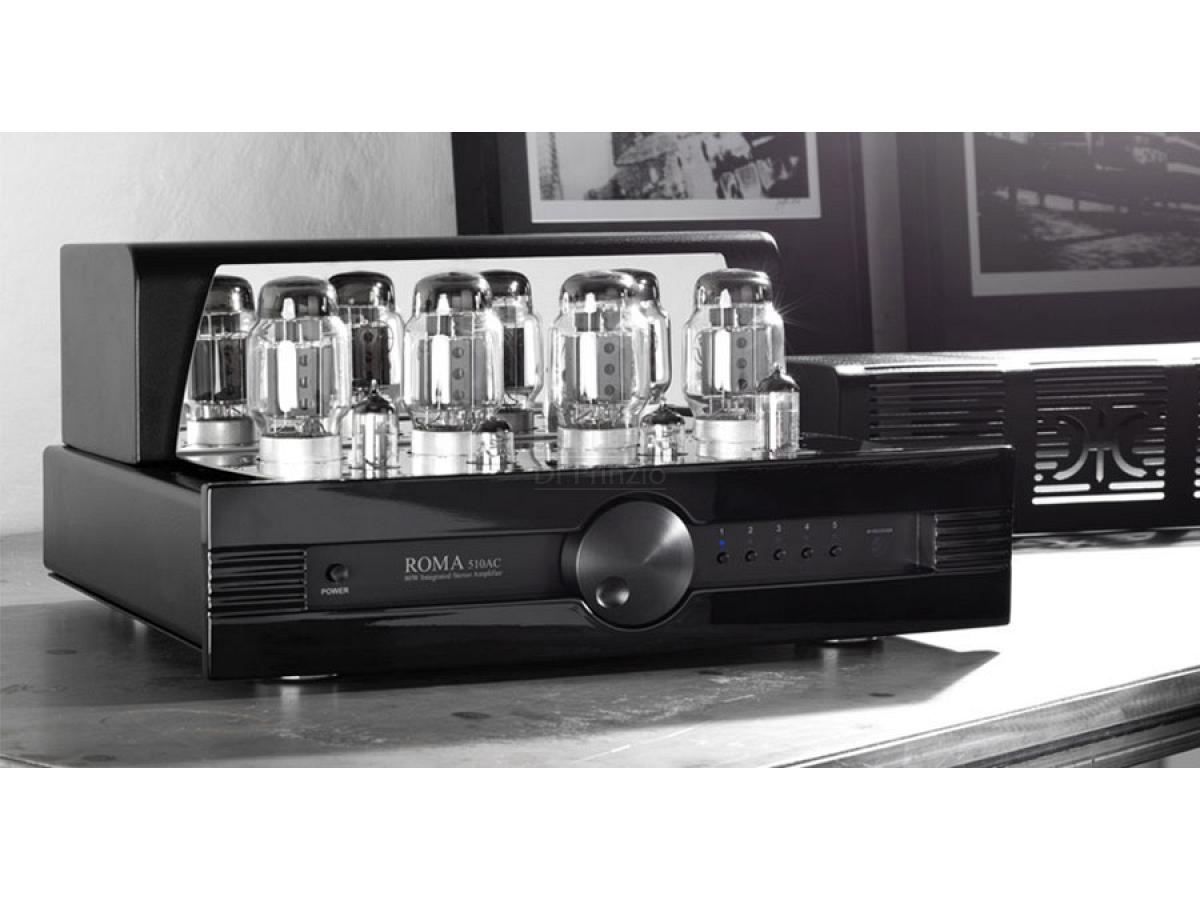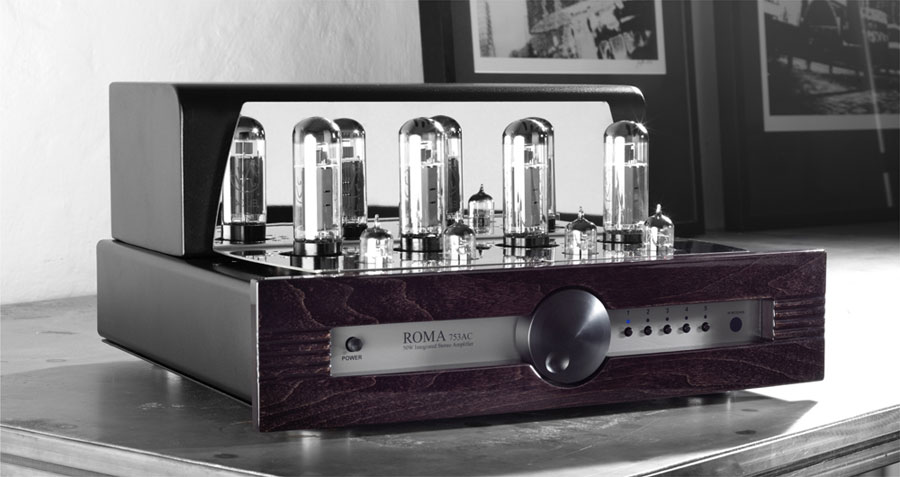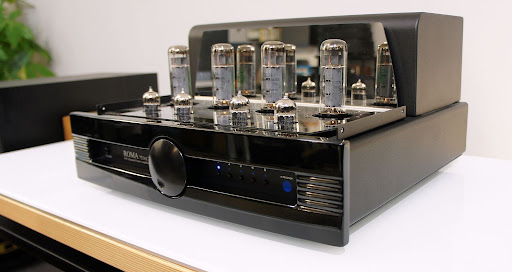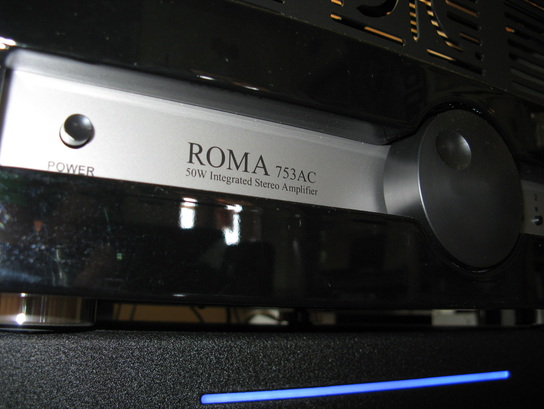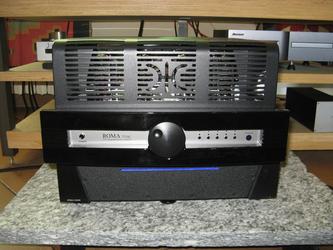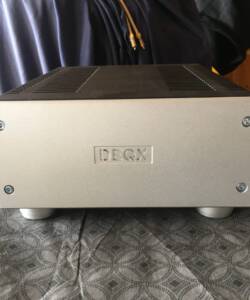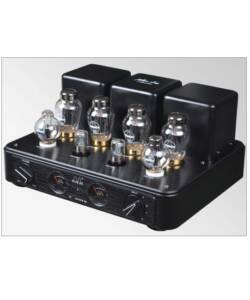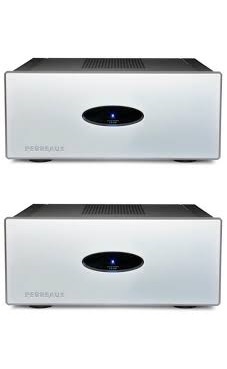Synthesis ROMA 753AC Integrated Tube Amplifier
Original price was: R95,000.00.R29,900.00Current price is: R29,900.00.
There has never been an introductory integrated amplifier with the fit, finish and sound of the ROMA 753AC. At first glance, this stunning amp simply takes your breath away. This high performance amplifiers brings out the best of other components in the system. Created by those obsessed with great sound and for those who love great music.The result is 50 watts of pure pentode output per channel built around a pair of 12AU7 on input/driver tubes and a pair of EL34/6CA7 power tubes in push-pull configuration for a detailed, delicate and dynamic sound.

FEATURES
- DC Powered tube heater
All tubes, except EL34, have DC stabilised heater circuits to reduce hum noise to a near in-audible minimum. - Output transformer
The Output transformer uses a Hi-Grade lron-Silicon for superb frequency reproduction & width. With this newly designed custom output transformer we are able to achieving a highly delicate & precise sound reproduction faithful to the originai recording. - Mechanical chassis construction
The power supply & output transformers are held by an extremely rigid structure that keeps the unit free from unwanted vibrations which further helps reduce unwanted noise to the tubes. - Remote control
It has a soft button design, perfectly matching the aesthetics for the “ROMA” series. It controls volume,mute and sources selection. - Feet
Four aluminium feet with an insert of strong rubber. These rubber feet has been choise to minimise vibrations of the amplifier in isolation from its surroundings. - Binding posts
Gold plated professional binding posts for a continued oxidisation free connection further improve sound refinement. - Sockets
Gold plated ceramic sockets for a continued oxidisation free connection further improve sound refinement. - Components
Components for the Roma 753AC have been selected with great care throughout. Only the best available components are considered & all must undergo an exhaustive analysis of their sonic influence prior to final selection. - Selected tubes
All tubes used are selected after 2 stage warm up. A fully computer monitored machine controls the process & at the end of this, selects the perfect tubes which are then matched for a perfect balance. 
-
Synthesis “Roma” 753AC
Right time, right place. This is what happened a Friday afternoon in July, when I visited my favorite Hi-Fi shop. The shop owner showed me two new items that had just arrived, two integrated amplifiers of the Italian firm Synthesis. Synthesis is well known for its products that are small and nice and high quality products. I was kind of curious about this brand. In fact, my friend Gabriele, that builds loudspeaker systems just for fun and for himself, used a small Synthesis integrated amp for one of his projects. He invited me to listen to it and the sound was a sound of quality, due partly to the loudspeakers and partly to the Synthesis amp, I guess.
The shop owner showed me the model “KT 88” – 90 watts per channel – and the “EL34” that has 50 watts per channel. I asked straight away to have one of them for a review; in fact August is for me a blessed month for reviews: it’s very calm and the neighbours are on holiday, so I can pump up the volume as much as I want, without disturbing anybody. Moreover, in August there is the “Milano ArteMusica” festival, so my ear is really well trained in listening to live music due to the high concentration of concerts.
I chose the amp with the EL34, the 753AC, while the other one with the KT88 is the 510AC, they both belong to the Series named “Roma”. The price is around 3.000,00 euros each of them; it is neither cheap nor expensive. Synthesis are well known for being very long lasting products and this is something to keep in mind when we want to buy something. Another important thing to keep in mind is that it’s easy to have them fixed, because the producer is on the market since a very long time; the distribution is made by Synthesis itself and this turns out to be a plus both for the distributing network and the buyer that has direct contacts with the producer.
The valves for the pre-amplifier section are the 12AU7; the valves of the amp are the EL34 that work in pentode mode. The producer explains that he uses high quality components, anti-oxidants ceramic pins for the valves, metallic pins and a very strong chassis, to avoid vibrations that may interfere with the tubes.
The amplifier is very small but heavy. Be careful when you take it out of the box, the transformers are placed in the rear part of the component and if you do not grab it under the rear side, it may slip from your hands. Since it is a very well refined object this would be a real shame.

The integrated has 5 inputs and 1 output for a possible external power amplifier; it also has a IEC for the a/c power and the speaker output connectors. The box is strong and big and the user’s manual has enough information in it (in fact there’s not much to do or understand, also because the component sets the bias of the valves by itself).
The fact that the initial stand-by (the valves warm-up as I call it) is indicated by the led lights on the inputs that blink until the component is ready to play, must be evidenced; the only led switched on will be the one on the input selected for the previous listening. The Roma has a nice sound even before the warm-up but after some time the sound seems more fluid.
The device is not noisy at all when the volume is turned up at its maximum and plays well also at very low volumes that suit listening rooms that are located in a condo.
There is no phono input. The trend is towards computer music so those that have a turntable own probably an external phono preamplifier. As I am devoted to analog music this is a small deficiency but I understand the reasons behind this choice.This Synthesis has been connected to the following system:
Bauer Audio DPS 2 turntable, Mørch DP6 tonearm, Transfigurationa Aria and Denon DL 103 cartridges, Pioneer PL 550 turntable with Ortofon MC 15 Super II cartridge, American Hybrid Technology –P e Lehmann Black Cube phono preamplifiers, Olimpia Audio Guglielmo II and Spectral DMC12 preamplifiers, Spectral DMA50 and Wyred4Sound ST 250 power amplifiers, Audio Note AN-E SPx loudspeakers, Systems & Magic, Kimber Kable, Audio Note, YBA and other cables.First of all, the Synthesis is very quiet, no bumps when you turn it on. The remote is really useful. It has a wide control adjustment, in the sense that when you adjust the volume, the volume goes up gradually and it helps you manage it at the level you prefer. This is a valve amplifier and during the listening you notice it.
The medium and medium high range are typical of a tube device, a good and serious one. The voices sound natural, they are never too forward or in emphasis, they are always well integrated in the music texture. The bottom range is always in place and sometimes even a bit too shy – at least with the AN E speakers – the low extension is good, let’s say that it’s controlled but not short. The extreme is a bit faded, listening to the Vespro della Beata Vergine by Monteverdi (Archiv, Gardiner) the voices, the horns, the trombones had all a very good sound, very captivating and most of all very credible. The treble voices were, together with the violins, put in a slight backward position but the sound was defined.
The dynamics of A Night in Tunisia, with Art Blakey and the Jazz Messengers, is not at all flat. This is a Vinyl record of the end of the 70’s, recorded by Philips with Direct Master technology; the dynamics is unlimited, so you turn on the volume consequently. The slightly amber high range helps to tame the cymbals that sound more natural with the solid state device that I usually use. The soundstage is very clear, both for sound and instrument positioning. The double bass and all the keys are well identified and all and the echoes of the sounding board are neither shortened nor prolonged.
This timbric attitude is perfect for everything that is sang. Very convincing the voices in the Haendel’s Messiah (Hogwood on Oiseau-Lyre) and also the few voices present in the Mass in B Minor (Minkoski on Naïve). It’s been very amusing to listen to the changes that the sound engineers did to the soundstage of the Messiah, and to hear how well the Synthesis evidenced these changes. More static is the scene in the Mass in B Minor that privileges the voices on the music of the orchestra. Tympanis are far away and not clear, I like better the other version, with the Petite Bande directed by Sigiswald Kuijken on Challenge. The wood winds are very natural as confirmed by the listening of the flutes present in the Telefunken recordings and the clarinet of homonym concert by W.A. Mozart (Oiseau Lyre).
With the Synthesis, the characteristic voice of Catherine Bott is very well defined. I had the chance to go to her concert 3 years ago in Saint Malo (France) and I hear no difference when I listen to her very peculiar and a bit husky voice recorded on Oiseau-Lyre entitled Virtuoso Italian Music.
All music genres are well reproduced, also those that require high volume such as rock music. I do not know if the sensitivity declared by Peter Qvortrup of his ANs is real, but with 50 W for each channel of the Synthesis the high volume reached was barely tolerable. Well this integrated device succeeded in taming the ANs and controlled them well.If the recording is not a good one this component lets you know it straight away; it is not characterized and characterizing. This feature in my opinion is always very positive.
I tested it with many different songs and pieces and the only time I felt it was in a tight spot I was listening to Départ by Wolfgang Rihm (Wien Modern, DGG) and the Miserere by Arvo Part (Hilliard, ECM). In this case, only in the low range there is a bit of confusion, it’s monotone, but it’s not different from what I listened with other valve amplifiers. If the latter do not have enough power, they always have this limit. The fact that with these two records the low range is very confused and it’s not so with other records, such as for example Sacre du Printemps or l’Oiseau de Feu by Stravinski (Dorati, Decca) remains a mystery. I gave myself an answer that may not be correct but makes sense to me. I think that the series of low sounds present in the two modern executions, being somehow continuous, are harder to reproduce than the violent hits on the bass drum that characterize “Igor’s music”.
What else shall I say? I agree that this integrated is not really cheap, but it is a quality product and the ratio quality-price is good. The price is in line with the competitors. It is very well built, it has a remote control and its sound is neutral. It has sufficient power to wake up many of the loudspeakers that are on the market now; it’s silent so it can be matched with high efficiency loudspeakers.
Italy, once again, strikes back!
Domenico Pizzamiglio
Translation: Francesca Rubino
Description
Specifications
Power output: 50 watts per channel into 6Ω (stereo)
Frequency response: 20Hz to 20kHz
Input sensitivity: 300mV (line)
Signal to noise ratio: 90dB (line)
Valve complement: 4 x 6CA7, 4 x ECC82
Dimensions: 410 x 330 x 260mm
Weight: 20kg
Accessories: RC5 infrared remote control




